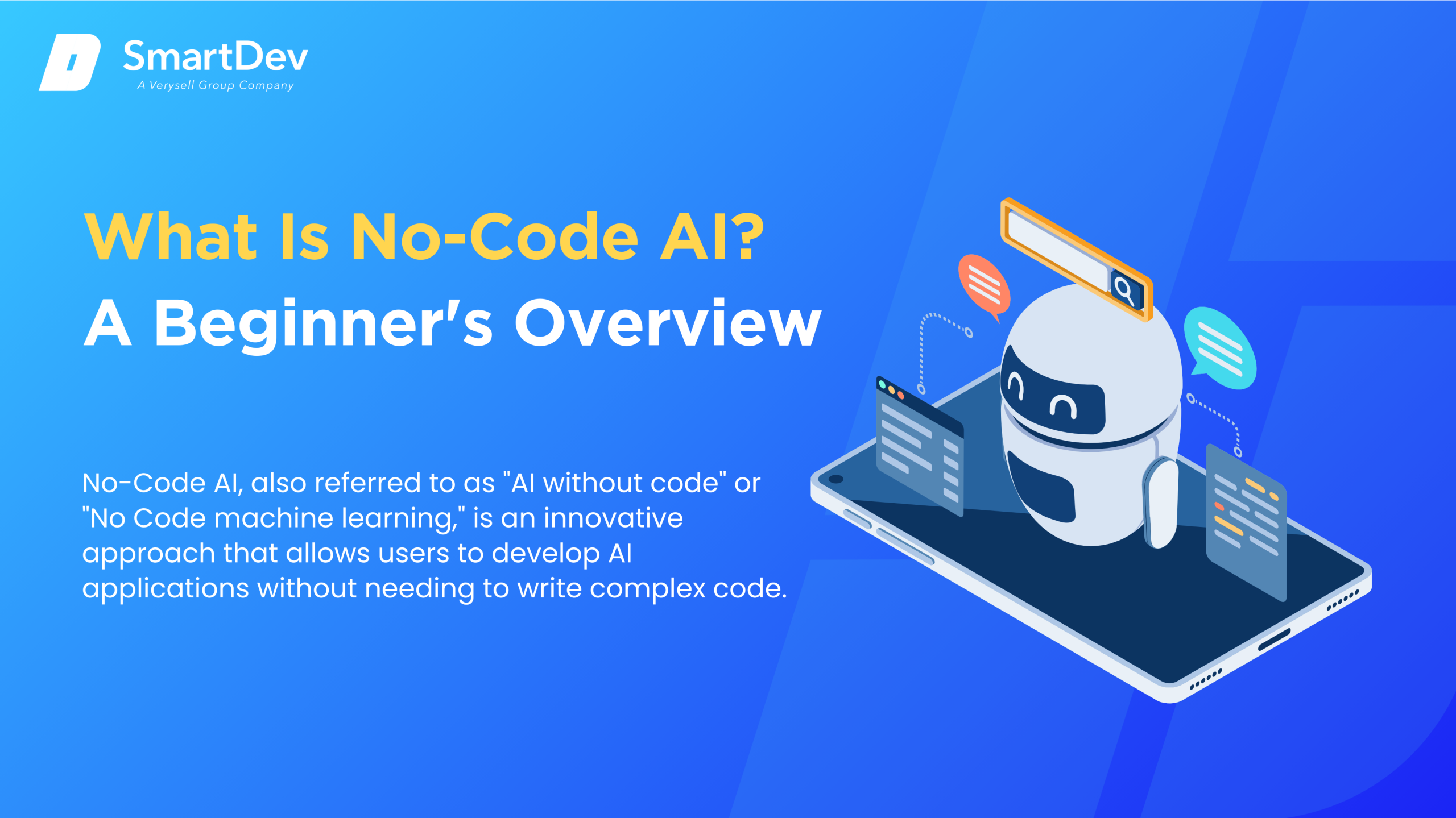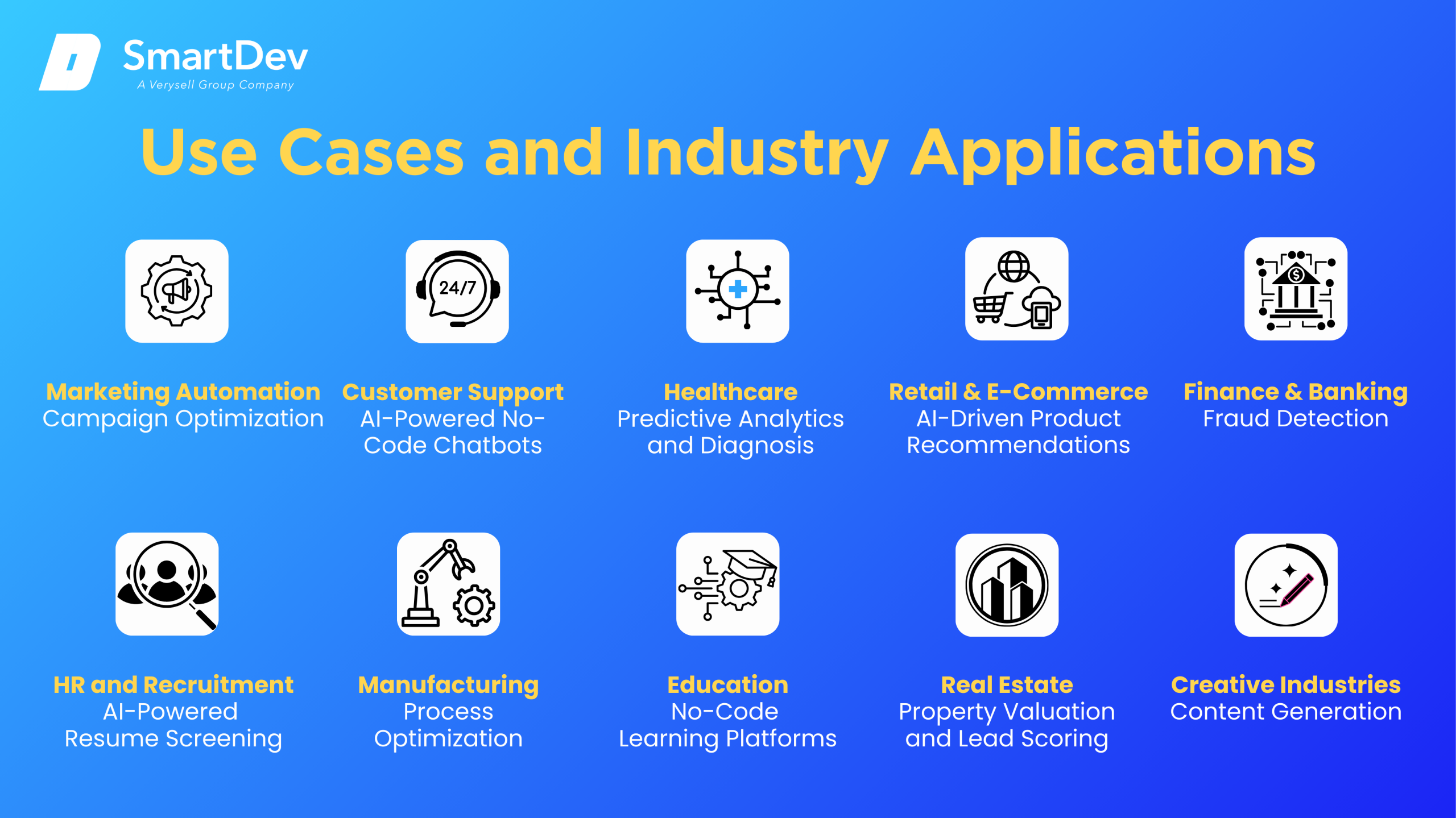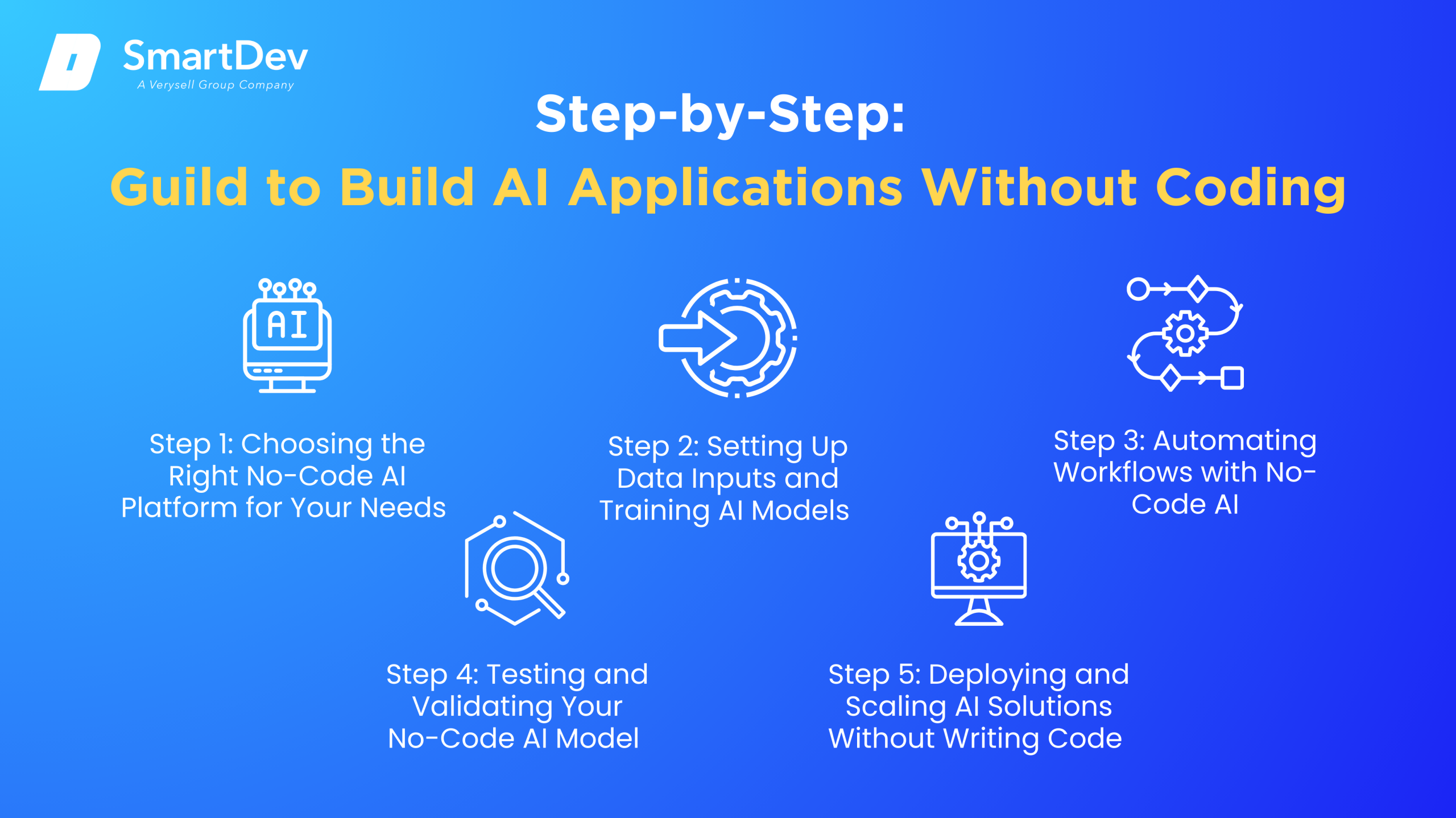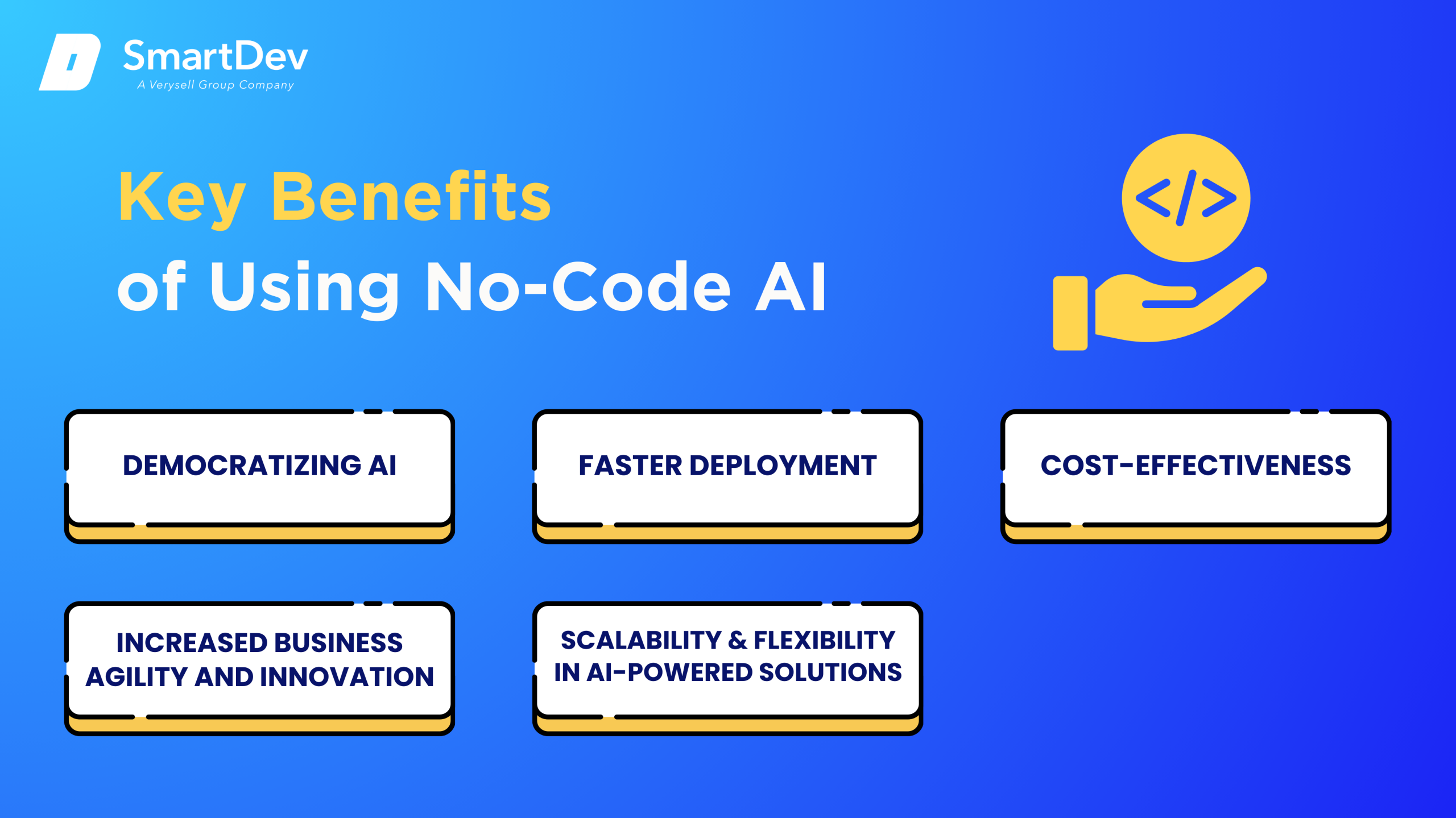Artificial intelligence (AI) has significantly advanced in recent years, driving intelligent automation across various industries. Among the most transformative advancements is the rise of the No-Code AI platform, representing a pivotal shift in how users with minimal technical expertise create and deploy AI-driven applications. These platforms offer intuitive drag-and-drop interfaces, pre-built AI models, automated workflows, and seamless integrations with existing enterprise systems, thereby accelerating AI deployment, reducing costs, and democratizing AI capabilities across different sectors.
1. Introduction to No-Code AI
 No-Code AI, also referred to as “AI without code” or “No Code machine learning,” is an innovative approach that allows users to develop AI applications without needing to write complex code. These platforms enable rapid prototyping, workflow automation, and AI decision-making without needing programming expertise, which is particularly beneficial for individuals who may not have a technical background but want to leverage AI technology for various applications.
No-Code AI, also referred to as “AI without code” or “No Code machine learning,” is an innovative approach that allows users to develop AI applications without needing to write complex code. These platforms enable rapid prototyping, workflow automation, and AI decision-making without needing programming expertise, which is particularly beneficial for individuals who may not have a technical background but want to leverage AI technology for various applications.
Key features of No-Code AI include:
- Graphical Interfaces: Users can interact with visual tools that simplify the process of building AI models, making it accessible to a broader audience.
- Pre-Built Components: Many No-Code platforms offer ready-made components that users can drag and drop into their projects, streamlining the development process.
- Empowerment of Non-Developers: This approach democratizes AI development, enabling business analysts, marketers, and other professionals to create AI solutions without relying on software engineers.
One of the key advantages of no code AI platform is its user-friendly interface, which empowers users to build and deploy AI solutions quickly and efficiently. By eliminating the need for complex coding, individuals can focus on the creative aspects of AI development, such as designing models and analysing data. This democratization of AI technology opens new opportunities for innovation and problem-solving across various industries.
Furthermore, No-Code AI platforms often come equipped with pre-built templates and drag-and-drop tools, making it easy for users to experiment with different AI functionalities. These platforms also offer tutorials and community support, allowing beginners to learn and grow their AI skills in a collaborative environment. As the demand for AI continues to rise, No-Code AI presents a promising pathway for individuals to enter the field and contribute to the advancement of artificial intelligence.
No-Code AI vs. Traditional AI: What’s the Difference?
Traditional AI development requires specialized technical knowledge, such as proficiency in programming languages like Python and R, and a solid grasp of machine learning and data science principles. These skills can be challenging for non-technical users, often making AI development inaccessible. In contrast, No-Code AI platforms simplify the process by offering visual, intuitive interfaces that enable users with little to no coding experience to create and deploy AI models. This streamlined approach helps lower costs, improve efficiency, and foster innovation, making AI more accessible to a broader audience.
The evolution of No-Code AI has transitioned from basic rule-based systems to advanced intelligent automation, significantly enhancing accessibility and functionality. Initially reliant on predefined rules, No-Code platforms now incorporate machine learning and natural language processing, allowing users without technical expertise to create dynamic applications that can learn and adapt over time. These advancements are making AI more accessible and fostering innovation across industries.
No-Code AI represents a transformative advancement for both businesses and individuals, enabling them to harness sophisticated technologies without requiring deep coding expertise or substantial financial resources. By automating tasks and enabling rapid experimentation, No-Code AI boosts productivity and adaptability, offering a competitive edge in fast-changing markets. As these platforms evolve, they continue to empower organizations to innovate and stay ahead of the curve.
2. How No-Code AI Platforms Work
No-Code AI platforms simplify AI application development for non-technical users through several key components. These platforms feature user-friendly interfaces with drag-and-drop functionalities, allowing users to build and customize AI models without writing code. Additionally, they provide a library of pre-built templates and machine learning models tailored to common tasks, enabling users to quickly adapt to specific needs. Guided workflows help users navigate the development process, ensuring successful creation of AI applications even with minimal technical expertise.
Data integration tools facilitate the management of various data sources needed to train models, while real-time data processing capabilities enable the analysis of live data for timely decision-making. Collaboration features allow multiple users to work on projects simultaneously, enhancing teamwork. APIs and plugins ensure seamless integration with existing business software, promoting smooth data flow across the organization. With these features, No-Code AI platforms enable users to efficiently develop AI applications through accessible interfaces, pre-built resources, and robust integration capabilities.
Drag-and-Drop Interfaces vs. Pre-Built AI Models
In No-Code AI platforms, drag-and-drop interfaces and pre-built AI models cater to different user needs. Drag-and-drop interfaces are user-friendly, allowing non-technical users to visually build workflows and quickly prototype applications. These interfaces offer customization options, enabling users to tailor applications to their needs with real-time visual feedback.
Pre-built AI models, on the other hand, provide ready-to-use solutions for tasks like natural language processing and predictive analytics. These models save users time by offering expert-designed, reliable solutions without the need for coding. Easily integrated into applications, they enhance projects with advanced AI capabilities quickly and efficiently.
Together, these features make AI development more accessible and efficient, allowing users to create customized applications or leverage expert-driven solutions for common tasks. The combination fosters innovation and improves operational efficiency, enabling faster AI adoption across industries.
The Role of APIs and Integrations in No-Code AI
APIs (Application Programming Interfaces) and integrations are essential components of No-Code AI platforms, significantly enhancing their functionality and user accessibility. They facilitate seamless data exchange between various applications, allowing users to pull data from multiple sources to train AI models and generate insights. By integrating with existing software tools, such as CRM systems and analytics platforms, No-Code AI solutions can extend their capabilities and streamline workflows, enabling users to automate tasks without writing code. This democratization of AI technology empowers non-technical users to create customized applications that meet their specific needs while ensuring scalability and flexibility as business requirements evolve.
APIs and integrations are fundamental to the success of No-Code AI platforms, empowering users to create interconnected applications that leverage data and functionality from various sources. This not only enhances the overall effectiveness of AI solutions but also allows businesses to scale their operations and adapt to changing needs without the complexities associated with traditional coding.
How Machine Learning Works in No-Code Platforms
Machine learning in No-Code AI platforms simplifies the development of AI models by automating complex processes, making it accessible to users without programming skills. The process begins with data collection, where users can easily import data from various sources such as databases and spreadsheets. Once the data is gathered, the platform automates data preprocessing tasks, including cleaning and transforming the data to prepare it for model training.
Users can then select from a variety of pre-built machine learning algorithms, and the platform handles the training process, optimizing model parameters based on the input data. After training, models are evaluated using performance metrics, and users receive visual feedback to understand their effectiveness. Finally, deployment is streamlined, allowing users to integrate their machine learning models into applications with minimal effort, and some platforms even support continuous learning to keep models updated with new data.
No-Code, Low-Code, and Full-Code AI: Understanding the Differences
- No-Code AI platforms are designed for non-technical users who want to create applications without any coding knowledge. They utilize visual interfaces with drag-and-drop functionalities, allowing users to build applications by assembling pre-built components and workflows. However, customization options are limited, which may restrict the complexity of the applications that can be developed.
- Low-Code AI platforms cater to users with some technical knowledge, including professional developers and IT teams. They combine visual development tools with the option to write custom code, providing greater flexibility than No-Code AI platforms. This allows for more customization options, enabling developers to extend functionalities and create more complex applications.
- Full-Code AI platforms are geared towards experienced developers who require maximum control over the application development process. This approach involves writing the entire codebase manually using programming languages and frameworks, offering complete customization and flexibility.
Choosing between No-Code, Low-Code, and Full-Code AI depends on your project goals, team capabilities, and desired scalability. No-Code is ideal for rapid deployment and user-friendly interfaces, while Low-Code offers a middle ground for growing businesses that need agility with some customization. For enterprises aiming to build sophisticated, large-scale AI solutions, Full-Code development delivers unmatched precision and performance. Understanding these distinctions helps you align your AI strategy with the right development path for long-term success.
3. Key Benefits of Using No-Code AI
3.1. Democratizing AI: Making AI Accessible to Non-Developers
One of the most transformative benefits of a No-Code AI platform is its ability to democratize artificial intelligence, which makes it accessible to non-developers. By lowering the barriers to entry, these platforms foster inclusivity and broaden the scope of AI applications across various industries. This shift not only broadens participation in AI initiatives but also fosters a culture of innovation across organizations, allowing diverse teams to contribute to problem-solving and application development.
3.2. Faster Deployment: Reducing AI Development Time from Months to Days
A No-Code AI platforms enhances business agility and innovation by enabling rapid prototyping and deployment of AI applications. This acceleration allows organizations to swiftly adapt to evolving market demands and customer needs, fostering an environment where teams can experiment with new ideas without extensive coding expertise. Consequently, businesses can implement changes more rapidly, gaining a competitive edge in the marketplace.
3.3. Cost-Effectiveness: Cutting Down on AI Development Costs
The ability to build and deploy AI solutions quickly also leads to substantial cost savings. A No-Code AI platform reducing the need for specialized AI developers and extensive infrastructure. These platforms enable organizations to develop and deploy AI solutions without hiring expensive, hard-to-recruit coders, leading to substantial savings in development and maintenance costs. Additionally, many No-Code AI platforms operate on subscription models, making them financially accessible for startups and small to medium-sized enterprises. This affordability allows businesses to experiment with AI technologies without incurring substantial financial risks, further enhancing their ability to innovate and remain competitive.
3.4. Increased Business Agility and Innovation
No-code AI platforms enhance business agility and innovation by enabling rapid development and deployment of AI applications. With intuitive visual interfaces, teams can quickly prototype, test, and refine ideas, allowing organizations to swiftly adapt to evolving market demands and customer needs. This streamlined process not only accelerates time-to-market but also fosters a culture of innovation, empowering employees to focus on creative problem-solving and the development of new functionalities without extensive coding knowledge.
3.5. Scalability and Flexibility in AI-Powered Solutions
No-code AI platforms empower users to swiftly develop and enhance applications through intuitive drag-and-drop interfaces and visual workflows. This streamlined approach enables rapid adaptation to market changes and evolving consumer demands. As businesses expand, these platforms facilitate seamless scaling of AI solutions, allowing users to start with basic applications and progressively incorporate advanced features without extensive reconfiguration or coding. This ensures that AI solutions remain effective and aligned with business growth over time.
4. Top No-Code AI Platforms in 2025
In 2025, No-Code AI platforms are democratizing access to artificial intelligence, allowing organizations and individuals to leverage advanced capabilities without technical expertise. These platforms support a wide range of solutions, including workflow automation, data analysis, and app development, driving innovation across industries. The following overview highlights the leading No-Code AI tools of the year, each offering distinct functionalities tailored to varying business and development needs.
- Zapier: Renowned for its AI-powered workflow automation, Zapier is a popular No-Code AI platform that allows users to connect various applications seamlessly, creating automated workflows known as “Zaps.” This facilitates streamlined operations and enhanced productivity without the need for coding.
- Bubble: Bubble is a versatile platform that empowers users to build complex web applications with AI functionalities. Its visual programming interface enables the design of applications through drag-and-drop elements, integrating AI features via APIs, making it ideal for entrepreneurs and businesses seeking efficient custom web solutions.
- Levity: Focused on business automation, Levity allows users to create custom AI models tailored to specific needs. By training AI models to categorize and process data from various sources like emails and documents, it enhances operational efficiency through a user-friendly interface accessible to non-technical users.
- Make (Formerly Integromat): Make is a powerful platform for automating complex workflows by connecting different applications and services. It offers a visual interface for designing automation scenarios, enabling seamless integration of AI functionalities suitable for businesses aiming to optimize processes and boost productivity.
- Peltarion: Designed specifically for deep learning applications, Peltarion provides tools to build, train, and deploy deep learning models without requiring extensive technical expertise. Its focus on accessibility allows businesses to leverage advanced AI capabilities for applications ranging from image recognition to predictive analytics.
- Lobe by Microsoft: A no-code machine learning platform that simplifies building image recognition models. Users can train models by uploading and labeling images, allowing Lobe to automatically generate a tailored machine learning model, making it particularly useful for businesses implementing image recognition technology without deep technical knowledge.
- Teachable Machine by Google: Teachable Machine is a user-friendly tool enabling quick and easy creation of machine learning models. Users can train models to recognize images, sounds, or poses using a simple interface, making it an excellent resource for educators, hobbyists, and businesses experimenting with AI without extensive coding.
- Landbot: Landbot specializes in creating conversational chatbots through a No-Code AI platform. Users can design interactive chat experiences using a visual interface, integrating AI capabilities to enhance user interactions, ideal for businesses aiming to improve customer engagement and support through automated chat solutions.
- Akkio: Focused on data analysis and predictive modeling, Akkio allows users to create custom AI models that analyze data and generate insights without programming skills. This is particularly beneficial for businesses leveraging data-driven decision-making without extensive technical resources.
- Glide: Glide is a No-Code platform that enables users to create mobile applications directly from Google Sheets. With its AI-powered features, users can build data-driven apps that automatically update as the underlying data changes, making Glide an excellent choice for businesses looking to develop mobile solutions quickly and efficiently.
5. Use Cases and Industry Applications

- Marketing Automation: No-Code AI platforms are transforming marketing automation by enabling businesses to create personalized marketing campaigns without technical expertise. These tools support automate of email marketing, audience segmentation, and customer behavioral analytics, leading to data-driven strategies that improve engagement and boost conversion rates in real time.
- Customer Support: AI-powered chatbots built on No-Code platforms are revolutionizing customer support by providing instant assistance and improving user experience. These chatbots manage common inquiries, guide users through processes, and escalate issues to human agents when necessary. By automating customer interactions, businesses can reduce response times and improve customer satisfaction while freeing up human agents for more complex tasks.
- Healthcare: In the healthcare sector, No-Code AI solutions are being utilized for predictive analytics and diagnosis. These platforms support the creation of personalized treatment plans while reducing administrative burdens, allowing healthcare professionals focus more on patient care and improve patient health outcomes.
- Retail and E-Commerce: Retail and e-commerce platforms are leveraging No-Code AI to implement intelligent product recommendation systems. By analyzing customer behavior and preferences, these systmes personalizze the shopping experience, increase conversions, drive loyalty, and enhance overall customer satisfaction.
- Finance and Banking: Financial institutions are adopting No-Code AI to detect fraudulent activities. These systems identify irregularities in transaction patterns and flag anomalies that may indicate fraud, enabling faster responses and better risk management, while enhance customer asset security.
- HR and Recruitment: Recruitment processes are becoming more efficient through No-Code AI solutions that automate resume screening. These tools assess qualifications and skills sets at scale, helping HR professionals identify the best candidates more efficiently.
- Manufacturing: In manufacturing, No-Code AI solutions are being implemented for process optimization. By analyzing production data, these platforms identify inefficiencies and suggest improvements, helping manufacturers reduce waste and increase productivity.
- Education: Educators are adopting No-Code AI to develop adaptive learning experiences tailored to individual student needs. By leveraging AI to analyze student performance and engagement, educators can provide targeted support and resources, ultimately improving learning outcomes.
- Real Estate: No-Code AI platforms are used for property valuation and lead scoring. These systems analyze market data and property features to provide accurate valuations, while also scoring leads based on their likelihood to convert. This enables real estate professionals to prioritize their efforts and make data-driven decisions.
- Creative Industries: No-Code AI is transforming the creative industries by enabling content generation. These platforms can assist in creating written content, graphics, and even music, allowing creators to focus on higher-level creative tasks. By automating repetitive aspects of content creation, businesses can enhance productivity and innovation in their creative processes.
6. Challenges and Limitations of No-Code AI

While No-Code AI platforms offer a great way to democratize access to artificial intelligence, there are several challenges and limitations that users need to consider before adopting them for more advanced applications.
6.1. Customization Limits: When No-Code AI Falls Short
No-Code AI platforms are designed to simplify the process of AI deployment, but they often come with limitations in customization. Users may find that pre-built templates and models lack the flexibility needed for complex or unique business requirements, making it difficult to tailor solutions to specific needs. As a result, organizations may face challenges in achieving the desired performance and outcomes.
6.2. Data Privacy and Security Concerns
With No-Code AI platforms typically operating in the cloud, data privacy and security become significant concerns. Sensitive information may be stored off-site, raising the risk of data breaches or unauthorized access. For businesses handling regulated or confidential data, ensuring compliance with privacy laws can be difficult without full control over the platform’s infrastructure.
6.3. Model Interpretability and Explainability Issues
No-Code AI models, especially those built on complex algorithms, often lack transparency in how decisions are made. This can be problematic in industries like healthcare or finance, where model explainability is vital for trust and regulatory compliance. Users without technical expertise may struggle to understand or interpret the underlying model processes, further complicating decision-making.
6.4. Scalability Challenges for Enterprise AI Needs
While No-Code AI platforms are well-suited for small-scale projects, they may not be able to handle the scale required by large enterprises. As businesses grow and their AI needs become more complex, No-Code tools may struggle to process large volumes of data or integrate with existing systems. This makes scaling up to enterprise-level operations a challenge, often requiring more custom-built AI solutions.
Despite these challenges, No-Code AI platforms continue to evolve and may still be a viable solution for many businesses, especially those in the early stages of AI adoption or those with less complex needs. However, it’s important to weigh the limitations against the benefits before committing to a platform.
The Future of No-Code AI: Will It Replace Traditional AI Development?
While No-Code platforms democratize access to AI and enable rapid prototyping, they are unlikely to fully replace traditional development methods. Complex AI applications that require deep customization, advanced algorithms, and high scalability will still necessitate skilled developers. Instead, No-Code AI is expected to coexist with traditional approaches, serving as a complementary tool for specific use cases and user groups.
7. Step-by-Step Guide to Building AI Applications Without Coding
Effectively developing AI applications using No-Code AI platforms requires a systematic, phased approach to ensure comprehensive coverage of key elements and alignment with strategic objectives.

Step 1: Choosing the Right No-Code AI Platform for Your Needs
The foundation of a successful no-code AI project begins with selecting the right platform. Evaluate platforms based on user-friendliness, customization options, and AI capabilities. Look for intuitive interfaces that allow you to design applications easily, as well as features that enable you to integrate advanced machine learning algorithms and natural language processing tools. Prioritize platforms with intuitive drag-and-drop interfaces, robust documentation, and scalability to match your long-term goals.
Step 2: Setting Up Data Inputs and Training AI Models
Once you have chosen a platform, the next step is setting up data inputs and training your AI models. Identify relevant data sources, whether they are internal databases, public datasets, or crowdsourced information. Clean and preprocess the data to ensure it is ready for training. This involves organizing the data, removing incomplete entries, and classifying it for better usability. After preparing the data, you can use the platform’s tools to train your AI model, adjusting parameters as needed to optimize performance.
Step 3: Automating Workflows with No-Code AI
Leverage the platform’s automation capabilities to build intelligent workflows that eliminate repetitive tasks. Many No-Code platforms offer features that allow you to create automated processes without writing code. You can set up triggers and actions that streamline repetitive tasks, such as data entry or customer interactions. This not only enhances efficiency but also allows you to focus on more strategic aspects of your business.
Step 4: Testing and Validating Your No-Code AI Model
Before going to deploying, perform comprehensive testing to validate the functionality and performance of your AI application. Conduct thorough testing to identify any bugs or issues that may affect performance. Utilize methods such as unit testing, integration testing, and user acceptance testing to ensure that your application functions as intended. Gathering feedback from end-users during this phase can provide valuable insights for improvements.
Step 5: Deploying and Scaling AI Solutions Without Writing Code
Finally, deploying and scaling your AI solutions without writing code involves selecting the right platform for launch and ensuring that your application can handle increased demand. Consider factors such as app store guidelines and compatibility with various devices. Once deployed, monitor the application’s performance and be prepared to make adjustments as necessary to accommodate growth and evolving user needs.
8. The Future of No-Code AI
The future of No-Code AI is poised for significant transformation, driven by advancements in generative AI and the increasing democratization of technology.
How Generative AI is Transforming No-Code Development
Generative AI is fundamentally changing No-Code development by enabling users to create applications more intuitively and efficiently. This technology allows non-developers to generate application components and templates from simple textual prompts, streamlining the development process. As a result, users can rapidly prototype and iterate on their ideas, making software development more accessible than ever before.
The rise of AI-driven citizen developers is another key trend shaping the future of No-Code AI. These individuals, often without formal programming backgrounds, are empowered by No-Code platforms to build their own applications and automate processes within their organizations. This shift not only enhances productivity but also fosters innovation, as more people can contribute to digital transformation initiatives.
Predictions for the Next 5–10 Years in No-Code AI
Looking ahead, No-Code AI in the next 5-10 years continues to expand its capabilities and adoption across various industries. As businesses increasingly recognize the value of agility and rapid deployment, No-Code solutions are expected to become integral to their operations. The market for No-Code AI platforms is projected to grow significantly, driven by the demand for faster application development and the need for organizations to adapt quickly to changing market conditions.
To prepare for an AI-first future, businesses should focus on integrating No-Code AI into their existing tech stacks. This involves educating employees about No-Code tools, selecting the right platforms that align with their needs, and fostering a culture of innovation where employees feel empowered to experiment with AI solutions. By doing so, organizations can enhance their operational efficiency and remain competitive in an increasingly digital landscape.
9. Learning from Success: No-Code AI Use Cases Across Industries
Businesses across various industries are successfully leveraging No-Code AI platforms to enhance their operations and drive growth. Here are some notable case studies that illustrate how organizations are harnessing this technology.
In one case, a small business automated its customer support using No-Code AI tools. By implementing a chatbot powered by AI, the business was able to handle common customer inquiries without human intervention. This automation not only reduced response times but also allowed staff to focus on more complex issues, ultimately improving customer satisfaction and operational efficiency.
A marketing agency also found success by utilizing No-Code AI for campaign optimization. The agency employed AI-driven analytics to automate client reporting and optimize marketing strategies based on real-time data. This approach saved the team significant time on manual reporting tasks, enabling them to concentrate on creative aspects and client engagement, which led to improved campaign performance.
In the healthcare sector, a startup built a predictive model without the need for developers by using No-Code AI platforms. This model analyzed patient data to predict health outcomes and optimize treatment plans. By empowering non-technical staff to create and manage the model, the startup was able to enhance patient care while minimizing the time and resources typically required for such complex projects.
Key Takeaways from These Success Stories
- No-Code AI democratizes access to advanced technology, allowing non-technical users to contribute to innovation.
- It significantly reduces the time and costs associated with developing AI solutions, enabling businesses to respond quickly to market demands.
- Organizations can achieve greater operational efficiency and improved customer experiences by automating routine tasks and leveraging data-driven insights.
10. Conclusion & Next Steps
Recap of Key Takeaways:
The rise of No-Code AI presents significant opportunities for businesses to enhance their operations and drive innovation without requiring extensive technical expertise. Key benefits include:
- Accessibility: No-Code AI platforms democratize technology, enabling non-technical users to build and deploy AI applications quickly and efficiently.
- Cost-Effectiveness: These tools reduce the need for expensive development resources, allowing businesses to implement AI solutions within budget constraints.
- Automation and Efficiency: By automating repetitive tasks, No-Code AI enhances productivity and allows teams to focus on strategic initiatives.
- Scalability: Many No-Code solutions are designed to grow with your business, adapting to changing needs and demands over time.
Is No-Code AI Right for Your Business?
The rise of the No-Code AI platform has opened new doors for businesses of all sizes—especially those without deep technical expertise. But the question remains: Is a No-Code AI solution the right fit for your business needs?
As you consider whether No-Code AI is right for your business, evaluate your specific needs and goals. If your organization seeks to streamline operations, enhance customer experiences, or leverage data-driven insights without the overhead of traditional development, a No-Code AI platform could be an excellent fit. Here are some expert recommendations to help you get started:
- Assess Your Needs: Begin by evaluating your business processes to identify areas where No-Code AI can add value. Consider tasks that are repetitive or data-intensive, as these are prime candidates for automation.
- Choose the Right Platform: Select a No-Code AI platform that aligns with your specific requirements. Look for user-friendly interfaces, robust integration capabilities, and scalability options to ensure the solution can grow with your business.
- Engage Your Team: Involve team members from various departments in the exploration and implementation of No-Code AI solutions. This collaborative approach can foster innovation and ensure that the tools meet the diverse needs of your organization.
- Start Small and Iterate: Begin with a pilot project to test the capabilities of your chosen No-Code AI platform. Use this opportunity to gather feedback, make adjustments, and refine your approach before scaling up to larger initiatives.
- Leverage Expert Support: Take advantage of SmartDev’s expertise and resources. Their team can provide guidance on best practices, help troubleshoot issues, and ensure that you are maximizing the benefits of your No-Code AI solutions.
- Monitor and Optimize: Once your No-Code AI applications are live, continuously monitor their performance and gather insights. Use this data to optimize processes and enhance the effectiveness of your AI-driven initiatives.
At SmartDev, we are committed to helping you harness the potential of No-Code AI tailored to your unique business needs. By staying informed and selecting the right development strategies, you can unlock the benefits of AI while maintaining control over your costs and resources. Embrace the future of technology with confidence and take the first step towards transforming your operations today.
Let’s work together to unlock the full potential of No-Code AI for your business. Contact SmartDev to explore how No-Code AI platforms can drive innovation and efficiency in your organization!
References:
- The Future of Intelligent Automation: How Low-Code/No-Code Platforms are Transforming AI Decisioning | IJECS
- Democratizing artificial intelligence: How no-code AI can leverage machine learning operations | Science Direct
- Human-Centered AI Product Prototyping with No-Code AutoML: Conceptual Framework, Potentials and Limitations | International Journal of Human–Computer Interaction
- Low Code and No Code Vs Traditional Development | techahead








